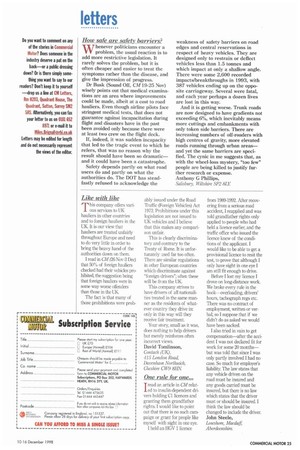letters
Page 27

If you've noticed an error in this article please click here to report it so we can fix it.
Do you want to comment on any of the stories in Commercial Motm? Does someone in the industry deserve a pat on the back—or a public dressing down? Or is there simply something you want to say to our readers? Don't keep it to yourself —drop us a line at CM Letters, Rm H203, Quadrant House, The Quadrant, Sutton, Surrey SM2 5AS. Alternatively, you can fax your letter to us on 0181 652 8971 or e-mail it to Miles.Brignall@rbi.co.uk Letters may be edited for length and do not necessarily represent the views of the editor.
How safe are safety barriers?
Whenever politicians encounter a problem, the usual reaction is to add more restrictive legislation. It rarely solves the problem, but it is often cheaper and easier to treat the symptoms rather than the disease, and give the impression of progress. Dr Busk (Sound Off, CM19-15 Nov) wisely points out that medical examinations are an area where improvements could be made, albeit at a cost to road hauliers. Even though airline pilots face stringent medical tests, that does not guarantee against incapacitation during flight and disasters have in the past been avoided only because there were at least two crew on the flight deck. If, indeed, it was sudden incapacity that led to the tragic event to which he refers, that was no reason why the result should have been so dramatic— and it could have been a catastrophe. Safety depends partly on what road users do and partly on what the authorities do. The DOT has steadfastly refused to acknowledge the weakness of safety barriers on road edges and central reservations in respect of heavy vehicles. They are designed only to restrain or deflect vehicles less than 1.5 tonnes and which impact at only a shallow angle. There were some 2,600 recorded impacts/breakthroughs in 1993, with 387 vehicles ending up on the opposite carriageway. Several were fatal, and each year perhaps a dozen lives are lost in this way.
And it is getting worse. Trunk roads are now designed to have gradients not exceeding 6%, which inevitably means more cuttings and embankments with only token side barriers. There are increasing numbers of off-roaders with high centres of gravity, more elevated roads running through urban areas— and yet the same barriers are specified. The cynic in me suggests that, as with the wheel-loss mystery, "too few" people are being killed to justify further research or expense.
Anthony G Phillips, Salisbury Wiltshire SP2 SLY












































































































